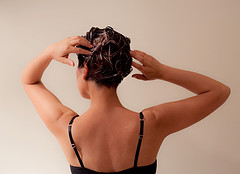
 We’ve been talking about several of the ingredients that are best to avoid when shopping for personal-care products. We’ve mentioned things like phthalates, parabens, synthetic fragrances, and formaldehyde. But we wanted to take a moment to put an even bigger warning behind four of the most dangerous-talc, powdered titanium dioxide, sunscreens, and certain dark hair dyes.
We’ve been talking about several of the ingredients that are best to avoid when shopping for personal-care products. We’ve mentioned things like phthalates, parabens, synthetic fragrances, and formaldehyde. But we wanted to take a moment to put an even bigger warning behind four of the most dangerous-talc, powdered titanium dioxide, sunscreens, and certain dark hair dyes.
We posted recently about talc-how studies have shown that women who used talc had a 33% higher risk of ovarian cancer, and how mothers using talc powder on babies could also be at higher risk. According to Samuel Epstein, MD, author of Toxic Beauty (Benbella Books, Inc., 2009), one in five premenopausal women continues to use talc as a dusting powder or on tampons. With such a strong connection to cancer, even the American Cancer Society says the findings are cause for concern. To protect your health, use talc-free ointments on babies and avoid powders in your personal care.
A similar risky product is powdered titanium dioxide. Don’t confuse this with the titanium dioxide used in sunblocks, as it poses no similar threat in non-powdered form and is actually currently considered one of the safest sunblocks available. However, powdered titanium dioxide-used to provide whiteness to cosmetics products-has been connected with cancer. High concentrations caused respiratory tract cancer in rats exposed in laboratory studies. Canada’s Centre for Occupational Health & Safety issued an alert in 2006 classifying the ingredient as a carcinogen, and advised employers to ensure that exposure to it was limited or reduced to the minimum possible. Since the powder comes as an ultrafine dusty powder, inhaling it is fairly easy to do. Women’s cosmetic powders may contain it-check ingredient labels!
Next-we’ve all learned to apply sunscreen to keep our skin safe from dangerous UV rays and to lower our risk of skin cancer. How disappointing to learn that many sunscreens have chemicals that have been linked to hormone disruption. We’ve warned you about these, so check out our posts and read ingredient decks. On the whole, avoid chemical sunscreens like oxybenzone and PABA, and go for physical options like zinc oxide and titanium dioxide. Don’t forget to reapply often, and don’t overestimate your protection. Reduce your time spent in intense sunlight and use sun-protective clothing when possible.
Finally, hair dyes. Black and dark-brown permanent and semi-permanent dyes may contain carcinogens. Even the National Cancer Institute warns us about these. “Over 5,000 different chemicals are used in hair dye products,” says their website, “some of which are reported to be carcinogenic in animals.” Though manufacturers changed the components in the 1970s to eliminate some of the suspected ingredients (like coal-tar-derived compounds), some studies have shown that people who started using hair dyes in the 1980s have an increased risk of developing non-Hodgkins lymphoma. Other population studies have shown an increased risk of bladder cancer in hairdressers and barbers. Studies of breast cancer have produced mixed results.
Does this mean you shouldn’t dye your hair? According to Dr. Weil, the International Agency for Research on Cancer (IARC) concluded that working regularly with hair dyes in salons and barbershops probably increases the risk of cancer, but that there is not yet enough evidence to conclude that occasional personal use of hair coloring raises the risk of cancer. Dr. Weil himself, however, recommends against artificial coloring agents. “In general,” he says, “I discourage the use of hair dyes containing artificial coloring agents, which to my mind are as suspect in cosmetic products as they are in food. Hair dyes applied to the head are absorbed through the scalp, where there’s a very rich blood supply that may carry them throughout the body.”
For non-toxic hair dyes, try organic hair dyes, or check out some of these homemade recipes.
Are you avoiding these four ingredients? Tell us about your favorite non-toxic brands.
Photo courtesy Bellisen via Flickr.com.

